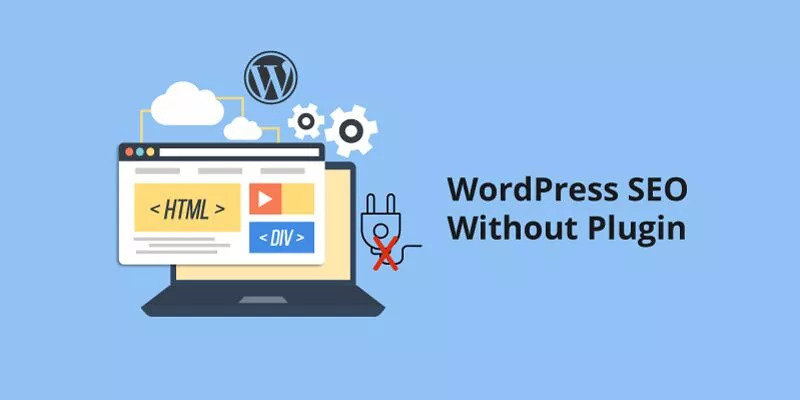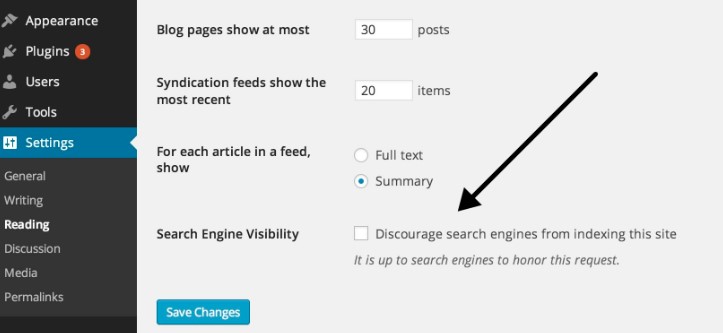X

WordPress SEO without SEO plugins is not only possible in 2025—it’s powerful and practical. While many site owners depend on tools like Yoast SEO WordPress or All in One SEO WordPress for quick SEO fixes, you can still achieve high Google rankings manually. Skipping plugins gives you more control, better speed, and fewer technical issues.
In this article, you’ll discover 7 powerful and beginner-friendly tips for doing WordPress SEO without any SEO plugins.. Whether you manage a WooCommerce site, an affiliate blog, or a personal website, these proven WordPress Tips will help you improve visibility, boost rankings, and take charge of your SEO-plugin-free.
Table of Contents
Using a WordPress SEO plugin like Yoast or All in One can simplify optimization tasks—but relying too heavily on them can slow down your website, cause compatibility issues, or even introduce security risks. Too many plugins can also make your WordPress dashboard cluttered and harder to manage.
Doing SEO manually gives you more control, improves site speed, and reduces technical problems. Plus, it sharpens your understanding of how search engines actually work, which is a major benefit if you’re serious about long-term success.
Think of this approach as a hands-on WordPress SEO tutorial. By learning to optimize titles, meta tags, URLs, and content without a plugin, you gain real SEO skills that make your site stronger, leaner, and more reliable.
| Feature | With Plugins (Yoast/All-in-One) | Without Plugins (Manual SEO) |
| Meta Titles & Descriptions | Easy with plugin | You need to add code in theme files |
| Sitemap | Automatically made | Use online tools like xml-sitemaps.com |
| Image Optimization | Plugin does it for you | You rename files and add alt text |
| Redirects | Easy via plugin settings | You edit .htaccess manually |
| SEO Tips | Built-in suggestions | You follow your own checklist |
| Speed Impact | May slow down your site | Your site stays fast |
This table helps you see that doing SEO without plugins means more manual work, but it gives you better speed and control.
To start WordPress SEO without plugins, first make sure your site is ready. A strong base helps everything else work better.
Your website should load fast and stay online all the time. A slow site can hurt your SEO because users don’t like waiting and search engines rank slow sites lower.
Choose managed hosting instead of shared hosting. Shared hosting means you share server resources with many other websites, which can slow your site down.
Some trusted companies are:
Managed hosting is a little more expensive, but it takes care of updates, backups, and performance.
N.B: Based on the latest WordPress security studies, insecure web hosting is the reason behind getting hacked for 41% of websites around the world. So don’t be a target for hackers by going with a shared hosting plan.
Pick a WordPress SEO-Friendly Themes that are:
Themes like Astra, OceanWP, or Neve are good choices. Using a good theme helps with WordPress content management and makes your site easier to use and faster to load.
Or else, go to CodeCanyon, check the reviews, ratings, and WordPress enthusiasts’ feedback on a theme, and purchase according to your needs.

It’s obvious that to get ranked high on SERPs, you need to make your site visible to search engines so that search engines can crawl and index your site instantly.
Go to your WordPress dashboard: Settings > Reading > Make sure “Discourage search engines from indexing this site” is unchecked.
If this box is checked, Google won’t be able to see or rank your site. Only check this when your site is under construction.
Keyword research is a primary and very important aspect of SEO strategy. To hit the G-spot of SEO, keyword research is a must.
Usually, search engines display results based on the queries of the users. And these queries of the users are the keywords that you need to research and find.
Here are the best WordPress tips to improve your SEO manually.
Every effective WordPress SEO tutorial starts with keyword research. Keywords are the terms people type into Google to find content. If you choose the right ones, you’ll bring more visitors to your site.
Instead of relying on a WordPress SEO plugin like Yoast SEO WordPress or All in One SEO WordPress to suggest keywords, you can do it manually using free tools like:
Focus on long-tail informational keywords—these are longer and more specific phrases that users often search for. Examples include:
Why long-tail? They’re easier to rank for, match specific search intent, and bring in better-targeted traffic. Mastering keyword research is one of the most important steps in improving your SEO, even without plugins.
Most WordPress SEO plugins automate your URLs, but you can set them up yourself easily. Clean URLs help both users and search engines understand your content.
To change your URL structure:
Go to Dashboard > Settings > Permalinks > Select “Post Name.”
This will change your links from something messy like:
example.com/?p=123
to:
example.com/wordpress-seo-tips
Follow these tips to create SEO-friendly URLs:
Using clear, descriptive URLs is a core strategy in any WordPress SEO tutorial. Whether you use Yoast SEO WordPress, All in One SEO WordPress, or go manual, your URL structure plays a major role in how to improve SEO in WordPress.
Your meta title and description appear on Google search results. A good title makes people want to click. A good description tells them what your page is about.
If you’re not using a plugin, you can add this code in your theme’s header.php file:
<title><?php bloginfo(‘name’); ?><?php wp_title(); ?></title>
<meta name=”description” content=”Your blog description here” />
Tips:
If you’re not comfortable editing theme files, ask a developer or consider using a simple SEO plugin.
You’ve written content and published it and are waiting for it to rank, is this work? We firmly say, No! Just writing content is not enough, rather you’ve to maintain SEO standards in your content.
The good news for SEO plugins (YoastSEO or RankMath) users is that they can see the SEO guidelines with all the analysis. As we’re talking about WordPress SEO without an SEO plugin, so you’ve to maintain certain things manually.
Use this WordPress SEO checklist:
If your content is helpful and well-written, Google is more likely to rank it higher.
Images help your blog look nice and explain your ideas better. But large images can make your site slow.
Here’s what to do:
This helps your site load faster and also helps people find your images through search engines.

A sitemap is a file that shows all the pages on your site. It helps Google find and index your pages.
To make one:
This is helpful especially if you have a new site, or you just finished a content migration.
Google wants fast websites. If your site is slow, people will leave, and Google will rank you lower.
Do these things:
You can test your site speed using Google Page Speed Insights.
If you want to go further, try these advanced but simple tips:
Sometimes, spam bots visit your site and slow it down. You can block them by adding their IP addresses to your .htaccess file:
<Limit GET POST>
order allow,deny
deny from 192.168.1.1
allow from all
</Limit>
Replace the IP with the one you want to block. This improves performance and security.
Schema markup gives extra information to Google. For example, it can show FAQs or ratings in search results. You can add it manually using JSON-LD format.
This is advanced, but helpful for a WordPress landing page or affiliate blog.
Use tools like:
These tools help you improve your strategy and content.
Doing SEO without plugins works great, but there are times when using one helps:
Yoast SEO WordPress and All in One SEO WordPress are the top plugins. They’re easy to use and offer suggestions as you write.
You don’t always need a WordPress SEO plugin to achieve great results. By following the manual steps shared in this guide, you’ve learned how to implement a powerful WordPress SEO checklist—from optimizing URLs and meta tags to improving image load speed and content quality.
If you’ve been searching for a practical WordPress SEO tutorial, this article walks you through each step without relying on tools like Yoast SEO WordPress or All in One SEO WordPress. While those plugins are popular, going manual gives you greater control, faster performance, and deeper insight into how to improve SEO in WordPress effectively.
Using long-tail informational keywords, writing clear and optimized content, and managing your posts with the WordPress Content Editor will not only boost your rankings but also build long-term value.
Need expert help? Consider hiring WordPress SEO services for advanced support. Otherwise, follow these WordPress SEO tips 2025, stay consistent, and watch your site grow—plugin-free and powerful!
Yes! While popular plugins like Yoast SEO WordPress and All in One SEO WordPress make SEO easier, you can manually optimize your site using proven WordPress SEO tips such as keyword research, clean URLs, and content optimization.
You can block IP addresses manually through your .htaccess file or using security tools. Blocking bad IPs reduces spam and improves site speed and security.
Important tips for WordPress SEO include using long-tail informational keywords, optimizing images, writing readable content, improving site speed, and leveraging internal linking.
Sharing your content on social platforms drives traffic, builds backlinks, and increases user engagement all factors that improve your SEO rankings.
Many online resources offer detailed WordPress SEO tutorials covering both manual SEO methods and plugin use, perfect for beginners and advanced users alike.
If you’re new to SEO or prefer automated suggestions, plugins like Yoast SEO WordPress or All in One SEO WordPress are helpful. They assist with meta tags, sitemaps, and keyword analysis.
A comprehensive WordPress SEO checklist covers keyword research, meta titles/descriptions, content quality, URL structure, image optimization, site speed, and sitemap submission.
Focus on manual optimizations such as setting SEO-friendly permalinks, adding meta tags in theme files, optimizing images, writing quality content, and creating an XML sitemap using online tools.
Long-tail informational keywords are specific and less competitive phrases. They help attract highly targeted visitors and improve your chances of ranking well on Google.
Yes, blocking spammy or malicious IP addresses improves website security and performance, which positively impacts your SEO rankings.
Use tools like Google Analytics and Google Search Console to monitor traffic, user behavior, and keyword performance without installing SEO plugins.
Professional WordPress SEO services offer expert optimization, technical fixes, and strategic guidance to boost your website’s ranking and traffic effectively.
Just fill out the contact form to get a free consultancy from our expert. We would be happy to answer you.
ThemeLooks – YouTube – Facebook – Linkedin – Twitter